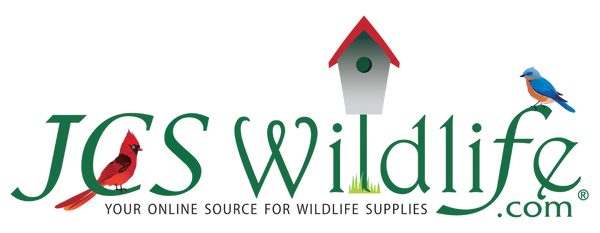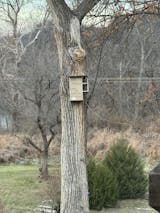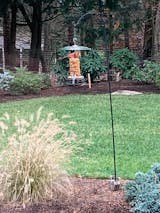Who doesn’t like a sweet treat every now and then? But just think… If you were a hummingbird, that “sweet treat” (along with a tiny insect here and there) is your main form of sustenance. How cool is that?
I want to talk mainly about hummingbird nectar today, but you can’t really do that without first saying a few things about hummingbirds themselves. I simply find these little creatures to be fascinating. Without going on and on about them for page after page, let’s just hit on some highlights that pertain to their diet.
- At a mere 2.5” tall, they eat more than twice their body weight…DAILY.
- Hummingbirds cannot store fat like many other species. Therefore, with their high metabolism, they must feed constantly.
- And speaking of metabolism, those little wings beat 50 times per second, or thousands of times per minute. And their heart rate clocks in at 1,260 beats per minute. No wonder they’re always eating!
Now, onto this nectar thing. When people think about hummingbirds and hummingbird nectar, most will envision some sort of red, sugary, syrupy substance that packs them full of energy. Well…that’s somewhat true, but there’s a bit more to it than that.
People have asked me, “How do I attract hummingbirds to my backyard? Can I hang a feeder and they’ll just show up?” It’s not always that easy. Hummingbirds have been around a lot longer than people have been feeding them. They are naturally attracted to the nectar that comes from plants growing where they live and raise their young. Makes sense, right? Native plants are best, but there are others too. I want to share what has worked for me to keep the list short. Salvia and fuschia are great for attracting hummingbirds to your yard. I have used a hanging basket for fuschia and placed a feeder nearby. In almost every case, hummingbirds will explore the plant first before going directly to the feeder. But what I have been most excited about was a pot of “bee balm” that a friend gave to me over 10 years ago. We transplanted some of this bee balm (which I had never heard of at the time) into a spot in our landscaping. What started out as a 12” square plot, has now grown along the fence line to occupy about 8 feet of space. We keep it controlled to that location - which I find easy to do. It comes back every year and requires little/no maintenance. Since it is native, I never water it. Pollinating bees love it - and so do hummingbirds! We have since started a patch of Bergmot, which is the more common, purple variety. What we have today is scarlet bee balm, or Monarda Didyma. It is fascinating to watch the hummingbirds feed from the bee balm nectar. And like the fuschia, we have strategically placed a feeder close to the bee balm. Again, they will visit the bee balm first, then move on to the feeder. So the short answer to the original question is, I recommend having hummingbird-friendly plants and then adding a feeder or two, or more…

But is it still possible to attract hummingbirds to your outdoor space without plants? Yes! It may not happen as fast, but if there are hummingbirds in your area, chances are they will visit your feeder. Hummingbird feeders are typically red. They may have some yellow or orange mixed in, but red is the norm. Think back to those native plants they like to visit. A lot of red, yellow and brightly colored blooms. In essence, the feeders are made to mimic the plant. And the “sugar water” offered in them is meant to be similar to plant nectar. Let’s talk about this sugar water for a bit.
As with the plant discussion, I am going to share some things that have worked for me, as well as knowledge I have gained from experts and research I have done over the years. There are many varieties of nectar out there that you can buy. JCs Wildlife offers a liquid nectar concentrate, as well as a powdered form; both of which you can simply mix with the appropriate amount of water. If you choose to mix your own nectar at home, I recommend using pure cane sugar (not beet sugar, honey or other sweeteners). The ideal sugar-water ratio is 1:4, or simply, 1 part sugar for every 4 parts water. It is best to boil the water to dissolve the sugar. I will typically boil 2 cups of water, then stir in 1 cup of sugar. Once the sugar has completely dissolved in the water, I will add more cold water to attain 4 cups of liquid total. I’ll make up to 2 quarts of this sugar-water mixture at a time, storing it in a repurposed ½-gallon juice jug in the refrigerator. If it’s mixed correctly and kept in the fridge between feeder fillings, the nectar should last you awhile, depending on how many feeders you are filling and how often you fill them.
Speaking of mixing and filling… At least here in Southern Indiana, our summers are very hot and humid. Like any other sugary mixture, hummingbird nectar will “go bad” at some point and need to be changed. If it’s less than 85-90 degrees, I recommend changing it every 2-3 days. But when the 90-degree temps roll in, you may want to consider changing out your nectar daily - or at least every other day. When I change out my feeders, I will use tap water and a brush to clean the feeder. Avoid using any chemicals when cleaning your feeders. If needed, a bit of vinegar can be used to aid in the cleaning process; but I find a simple scrub brush and garden hose are normally all that is needed. Please remember too that you don’t have to fill your feeders completely to the top. Most of the feeders I have seen will work just fine even when the nectar gets low. Don’t worry about your birds not being able to reach the bottom. A hummingbird’s tongue “rolls up” when retracted and unrolls when used to drink nectar. It is just as long as the beak, if not a tick longer. This gives the little guys quite a reach when drinking out of your feeders! So again, unless you have swarms of hummers drinking your feeders dry every day or 2, there is no need to completely fill them each time.
When talking about hummingbird nectar, I would be remiss if I didn’t at least mention the “red debate”. This is what I have learned. A lot of folks say “put red ON, not IN”. To that effect, natural nectar from flowers is clear. Therefore, the nectar in your feeders does not have to be red to successfully attract hummingbirds. The red on the feeder - and even the small amount of red on a feeding port - is enough to do the job. There is no scientific proof that I have read or heard about that says red nectar is harmful to the birds. At the same time, there are those that remain adamantly opposed to its use. I’m not a scientist, so I prefer to remain neutral on this subject until someone provides proof one way or the other. Personally, I use clear nectar because red-colored nectar is not necessary to attract hummingbirds; and well, I feel it’s better to be safe than sorry.
The bottom line here, folks, is that it’s fairly easy to jump on the hummingbird bandwagon and begin to enjoy seeing these fascinating little birds in your own yard. With that enjoyment comes some responsibility with keeping fresh nectar in your clean feeders. These little guys migrate for thousands of miles twice a year. We need to do our parts in helping them along their journey and as they raise their young in the summer. It’s as simple as hanging a single feeder and maintaining it properly. But be careful! And consider yourself warned! I have a friend, who at last count, told me she has over 30 feeders in her yard and goes through 25lbs of sugar every week! Yes, it’s possible to have this type of experience, based on where you live and how much time you have to dedicate to the birds. While I doubt there are many people like my friend out there, starting out with one feeder can lead to hours of enjoyment in your favorite outdoor space.



